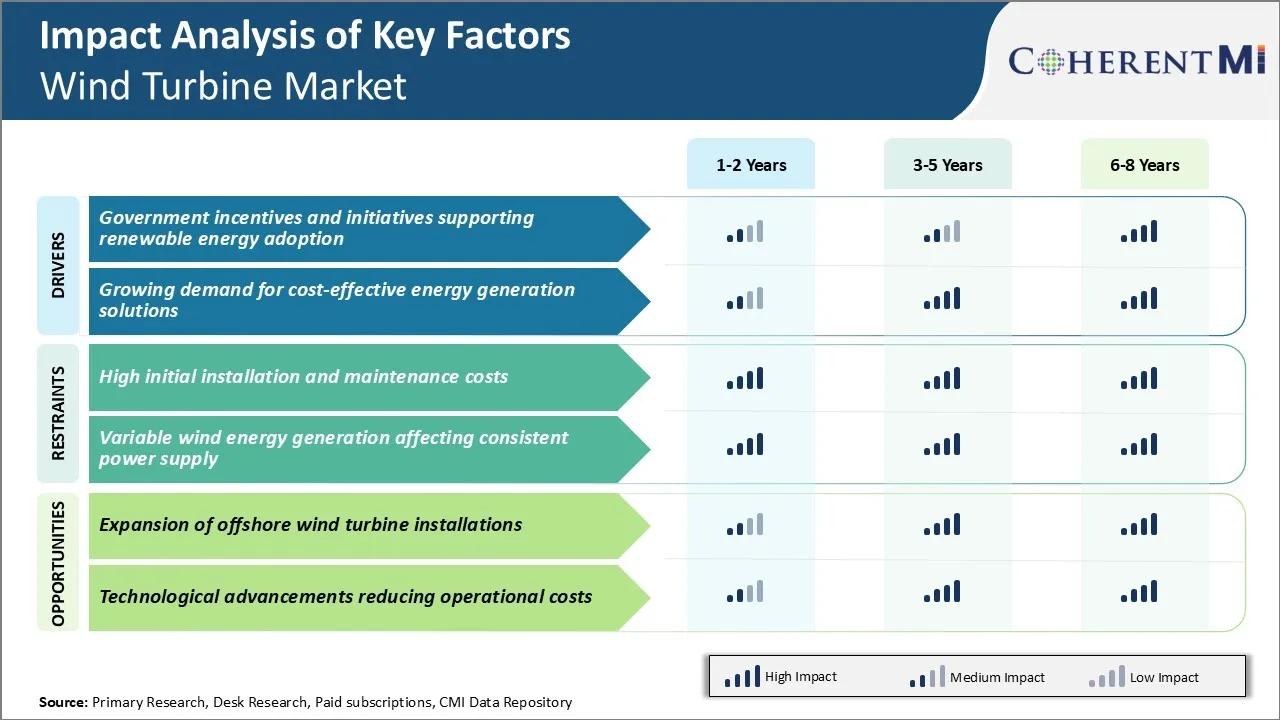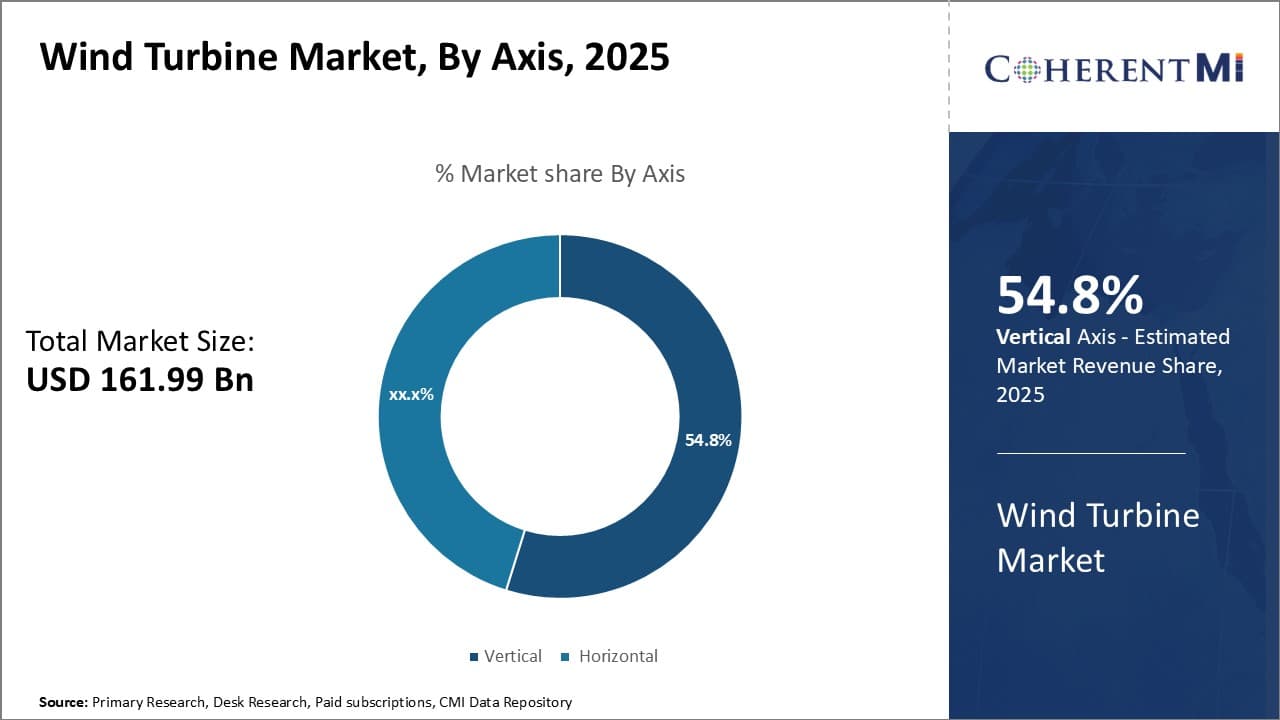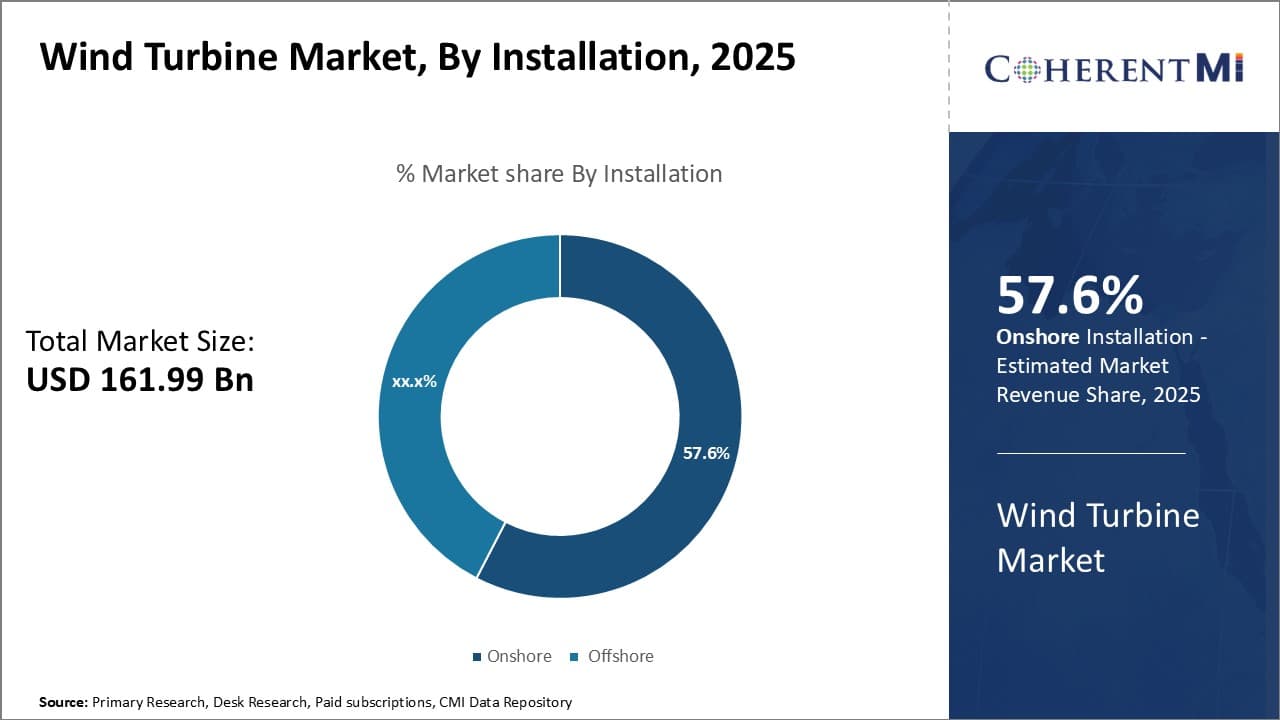

The wind turbine market is estimated to be valued at USD 161.99 Bn in 2025 and is expected to reach USD 277.62 Bn by 2032. It is projected to grow at a compound annual growth rate (CAGR) of 8.00% from 2025 to 2032. The wind turbine market has been witnessing significant growth driven by supportive government policies and regulations towards adoption of renewable sources of energy.
Market Size in USD Bn
CAGR8.00%
| Study Period | 2025-2032 |
| Base Year of Estimation | 2024 |
| CAGR | 8.00% |
| Market Concentration | Medium |
| Major Players | General Electric Company, Vestas Wind Systems A/S, Nordex SE, Suzlon Energy Limited, Siemens Gamesa Renewable Energy SA and Among Others |
Market Driver - Government Incentives and Initiatives Supporting Renewable Energy Adoption
Various governments around the world have introduced attractive incentives and policies to promote the use of renewable energy sources like wind power. This has significantly boosted the setting up of new wind farms in recent years. Many countries have set ambitious targets to increase the share of electricity generated from renewable resources as part of their commitments to reduce carbon emissions under the Paris Agreement. Achieving these targets requires massive investments in wind energy projects.
Governments offer lucrative tax incentives, rebates, and financial subsidies for both residential and utility-scale wind turbine installations. This makes wind power projects more viable economically for developers and lowers the per unit cost of energy generated. Overall, the growing policy push and financial assistance to boost renewable energy adoption is a driving factor augmenting investments and installations in the wind turbine market.
Market Driver - Growing Demand for Cost-effective Energy Generation Solutions
Soaring energy consumption worldwide along with rising electricity tariffs has intensified the need for reliable and affordable power sources across both developed and emerging economies. Meanwhile, traditional fossil fuel-based thermal generation is becoming increasingly expensive due to higher input costs and stricter emission norms.
This is propelling governments and large corporate buyers to explore renewable resources like wind that offer long-term electricity price stability along with environmental sustainability. Wind energy, in particular, is gaining popularity due to continual improvements in technology that have made it competitive against conventional power sources on cost.
Renewable costs are declining further with technological progress. Thereby, their price appeal compared to fossil alternatives will increase substantially over the coming decade. This will propel even greater demand for wind and solar installations as preferred choices for utility-level and distributed power generation.
 To learn more about this report, Download Free Sample Copy
To learn more about this report, Download Free Sample Copy
Market Challenge - High Initial Installation and Maintenance Costs
The high initial capital costs associated with installing wind turbines poses a significant challenge for the wind turbine market. Setting up both onshore and offshore wind farms requires massive upfront investments in purchasing and transporting large turbine components, foundations, cables, and substations.
For example, the average cost of installing an onshore wind turbine range between $1-2 million. On the other hand, an offshore turbine can cost upwards of $5 million due to additional expenses related to ocean logistics and infrastructure.
Furthermore, wind turbines have a lifespan of only 15-25 years and require regular scheduled and unscheduled maintenance to operate efficiently. Maintenance activities such as replacing worn components, painting, repairing blades and gearboxes generate substantial operating expenditures over the project lifetime.
The remote offshore locations further increase maintenance costs due to expenses related to vessels, crews and necessary downtime. With competition from relatively cheaper conventional power sources, high capital costs pose a considerable barrier for large scale adoption of wind turbine technology.
Market Opportunity - Expansion of Offshore Wind Turbine Installations
The expansion of offshore wind turbine installations across the world presents a major opportunity for the wind turbine market. Compared to onshore sites, offshore areas experience stronger and more consistent winds, allowing for larger, more productive turbines to be deployed. This translates to higher energy yields and returns on investment.
Many coastal nations are increasingly tapping into their vast offshore potential. They are and setting ambitious renewable targets that promise robust demand for offshore wind turbine projects in the coming decades. For example, countries like China, UK, Germany and others have outlined plans to install thousands of megawatts of offshore capacity through the 2020s and beyond.
Driven by supportive policies, technological advancements, and falling costs of offshore solutions, the global offshore wind turbine market is projected to grow at double digit rates over the next 10 years. Established and new players in the wind turbine market stand to benefit from proliferation of utility-scale offshore wind farms worldwide.
Strategy #1: Focus on innovation and R&D to develop advanced wind turbine technologies
Some of the major players like Vestas, Siemens Gamesa, General Electric have invested heavily in R&D to develop more efficient and powerful wind turbines.
Strategy #2: Pursue strategic acquisitions and partnerships for business expansion
Many companies have acquired or partnered with other players to expand their portfolio and geographic reach. For instance, in 2017, Siemens acquired Gamesa to become a global leader. Vestas partnered with Mitsubishi in 2018 for cooperation in developing offshore wind turbines.
Strategy #3: Focus on lowering levelized cost of energy (LCOE) through economies of scale
Players focus on increasing turbine size to reduce LCOE. For example, Vestas launched its largest onshore turbines V162-6.0 MW and V168-8.0 MW in 2019 and 2020 respectively. This allowed 10-15% reduced LCOE. GE launched its Haliade-X 12 MW offshore turbine in 2020, the most powerful one today.
Strategy #4: Expand to growing end-markets through timely market entry
Majority of demand is now coming from offshore and emerging markets. Vestas and Siemens Gamesa have proven successful due to their early focus on these opportunities.
 To learn more about this report, Download Free Sample Copy
To learn more about this report, Download Free Sample Copy
Insights, By Axis: Heightened Stability Drives Vertical Axis Segment Growth
In terms of axis, vertical contributes 54.8% share of the wind turbine market owning to its inherent stability compared to horizontal designs. Vertical axis turbines can operate in a wide range of wind directions without needing to mechanically change orientation. This makes installation and maintenance far simpler as there is no gearbox or motor needed for orientation.
The lack of complex internal components like gearboxes that are failure prone in horizontal designs further boosts reliability. Vertical turbines can operate continuously for a very long period without any interruptions even in turbulent wind conditions. This stability attracts many industrial and commercial customers who desire an uninterrupted power supply for their critical operations and equipment.
Inherent stability of vertical wind turbines compared to other axis orientations has cemented vertical axis segment's dominance in the current wind turbine market.
 To learn more about this report, Download Free Sample Copy
Insights, By Installation: Terrestrial Access Drives Onshore Segment Leadership
To learn more about this report, Download Free Sample Copy
Insights, By Installation: Terrestrial Access Drives Onshore Segment Leadership
In terms of installation, onshore installation contributes 57.6% share of the wind turbine market. This is owing to simpler access and deployment on land areas. Setting up wind turbines offshore requires specialized heavy-lift vessels and equipment along with complicated installation procedures at sea. High costs associated with equipment mobilization, transportation to site and actual installation at sea deter many project developers and operators.
Abundance of suitable relatively larger smooth land parcels in close proximity to demand centers aid concentrating more turbine installations onshore. Siting wind farms near towns and cities enables lower line losses during power evacuation through existing grids. This synergistic co-location with transmission infrastructure and load centers amplifies onshore segment growth in the wind turbine market.
Insights, By Component: Enhanced Durability Powers Rotating Blade Dominance
In terms of component, rotating blade contributes the highest share of the wind turbine market in 2024. This is due to advancements improving its longevity. Modern wind turbine rotating blades are engineered with durable composite materials like glass and carbon fiber reinforced polymers that withstand high centrifugal stresses better.
Sophisticated aerodynamic profiling and variable pitch capabilities help optimizing energy extraction even during transient gusty winds. Advanced coating technologies further augment blade service life by protecting against environmental degradation. Rotor blades therefore last significantly longer now without needing replacements, lowering lifecycle costs.
In summary, rotating blades have emerged as the flagship component driving higher penetration of wind turbines owing to longevity leadership achieved through cutting-edge material and engineering developments. This entrenched dominance is likely to hold strong in the wind turbine market going forward as well.
The major players operating in the wind turbine market include General Electric Company, Vestas Wind Systems A/S, Nordex SE, Suzlon Energy Limited, Siemens Gamesa Renewable Energy SA, China Shipbuilding Industry Corporation, Shanghai Electric, Windey Energy Technology Group Co Ltd, Goldwind Science & Technology Co., Ltd., Ming Yang Smart Energy Group Co. Ltd., Suzlon Energy Limited, Enercon GmbH, Envision Group, and Senvion S.A.
Would you like to explore the option of buying individual sections of this report?
Sakshi Suryawanshi is a Research Consultant with 6 years of extensive experience in market research and consulting. She is proficient in market estimation, competitive analysis, and patent analysis. Sakshi excels in identifying market trends and evaluating competitive landscapes to provide actionable insights that drive strategic decision-making. Her expertise helps businesses navigate complex market dynamics and achieve their objectives effectively.
Wind Turbine Market is segmented By Axis (Vertical, Horizontal), By Installation(Onshore, Offshore),...
Wind Turbine Market
How big is the wind turbine market?
The wind turbine market is estimated to be valued at USD 161.99 Bn in 2025 and is expected to reach USD 277.62 Bn by 2032.
What are the key factors hampering the growth of the wind turbine market?
High initial installation and maintenance costs and variable wind energy generation affecting consistent power supply are the major factors hampering the growth of the wind turbine market.
What are the major factors driving the wind turbine market growth?
Government incentives and initiatives supporting renewable energy adoption and growing demand for cost-effective energy generation solutions are the major factors driving the wind turbine market.
Which is the leading axis in the wind turbine market?
The leading axis segment is vertical.
Which are the major players operating in the wind turbine market?
General Electric Company, Vestas Wind Systems A/S, Nordex SE, Suzlon Energy Limited, Siemens Gamesa Renewable Energy SA, China Shipbuilding Industry Corporation, Shanghai Electric, Windey Energy Technology Group Co Ltd, Goldwind Science & Technology Co., Ltd., Ming Yang Smart Energy Group Co. Ltd., Suzlon Energy Limited, Enercon GmbH, Envision Group, and Senvion S.A. are the major players.
What will be the CAGR of the wind turbine market?
The CAGR of the wind turbine market is projected to be 8.00% from 2025-2032.